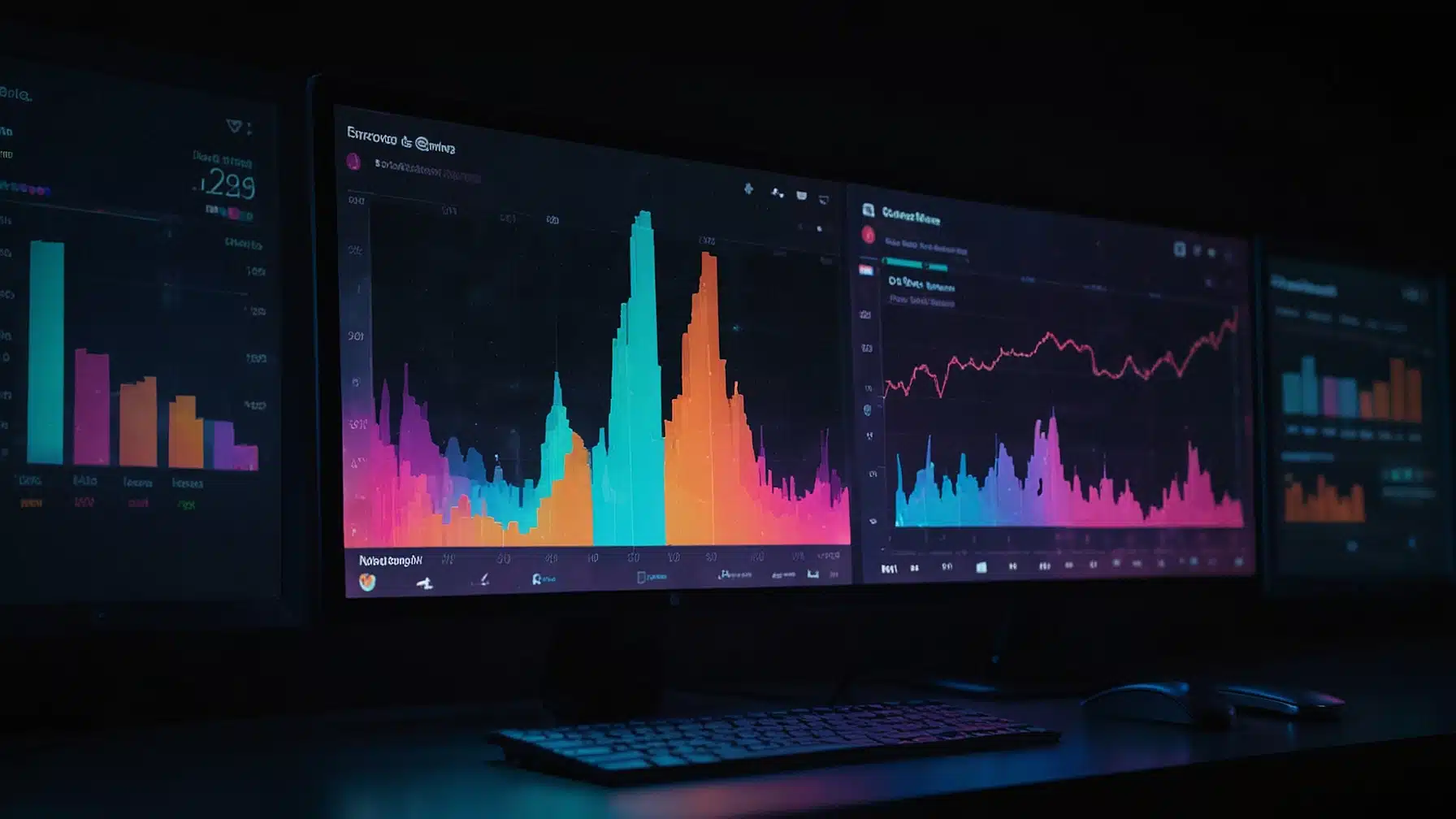To grow your YouTube channel, understanding YouTube analytics is key. The platform offers a range of metrics that can help you measure and improve the performance of your videos. Watch time is one of the most important metrics because it shows how long viewers are actually engaging with your content, which YouTube uses to decide which videos to promote.
In YouTube Studio, you can access several other vital metrics that are essential for a successful video marketing strategy. Channel views tell you how many times your videos have been watched, while engagement metrics indicate how viewers are interacting with your content. These insights are crucial for content creators aiming to increase their visibility and subscriber base.
Leveraging tools like Hootsuite’s Analytics and TubeBuddy can provide deeper insights into your channel’s performance. These platforms allow you to track keywords, analyze retention rates, and even compare your channel’s metrics to those of competitors. By regularly monitoring these analytics, you can fine-tune your marketing strategy and create video content that resonates with your audience.
Understanding Viewer Behavior
Understanding how viewers interact with your content is essential. By analyzing key metrics, you can gain insights into what content resonates most with your audience and make informed decisions about your strategy.
Watch Time and Retention
Watch Time measures the total minutes viewers spend watching your videos. It’s crucial because YouTube’s algorithm uses this metric to prioritize content. Higher watch times suggest engaging videos, leading to better placement in search results and recommendations.
Audience Retention shows how long viewers stay on your video. This metric helps identify Key Moments for Audience Retention, such as when viewers drop off or rewind. Analyzing these moments can guide you in creating more engaging content.
Tracking both Watch Time and Audience Retention is vital for understanding viewer engagement. Higher retention rates indicate compelling content. Comparing these metrics across videos can help determine what types of content work best.
Audience Demographics
Audience Demographics provide insights into who is watching your videos. Metrics include Age, Gender, and Location. Knowing if your audience consists of mostly males aged 18-24 or females aged 35-44 can shape your content strategy.
Unique Viewers count how many individual users watch your videos. This differs from views, which count total watches, even if the same person watches multiple times.
Understanding audience demographics helps tailor content to your viewer’s preferences. For example, if most viewers are from a specific country, consider adding subtitles or content relevant to that region.
Identifying Return Viewers also provides a sense of loyalty and interest in your content. With 1 Billion Hours Watched Daily on YouTube, attracting and keeping your audience is key to growth. Monitoring active users can help gauge the effectiveness of your engagement tactics.
Enhancing Channel Performance
To enhance your YouTube channel performance, focus on growing your subscriber base, optimizing video discoverability, and using analytics tools. Each of these areas plays a crucial role in expanding your audience and improving engagement.
Growing Subscriber Base
Subscribers are key to your channel’s growth. To increase subscriber growth, you need to consistently create engaging and valuable content. Encourage viewers to subscribe by including call-to-actions in your videos.
Focus on analyzing traffic sources. This helps identify platforms that drive the most viewers to your videos. YouTube Analytics Tools such as Hootsuite or Advanced Mode in YouTube Studio can track subscriber gains and losses. Pay attention to which videos drive the most subscribers and create similar content.
Track subscriber growth from thumbnails and titles. Create compelling thumbnails and titles with relevant keywords to increase your Click-Through Rate (CTR). Impressions Click-Through Rate (CTR) tells you how often viewers clicked on your thumbnail after seeing it in their feed.
Optimizing Video Discoverability
Improving video discoverability helps your content get seen by a wider audience. Use SEO techniques to ensure your videos rank high in YouTube Search and reach the right viewers. Optimize your titles, descriptions, and keywords to align with search intent.
Thumbnails play a significant role in catching viewers’ attention. Design eye-catching thumbnails that stand out in the search results. High-quality, relevant thumbnails increase the likelihood of clicks, which boosts your impressions and CTR.
Traffic sources give insights into where your views are coming from, whether it’s from YouTube search, external websites, or suggested videos. Optimizing for each source can help improve discoverability. Consider collaborating with other creators or promoting your videos on social media to reach a larger audience.
Using Analytics Tools
Using analytics tools helps you understand and improve your channel’s performance. YouTube Studio‘s Advanced Mode provides in-depth insights into all aspects of your channel’s performance. Monitor watch time, views, and subscriber growth regularly.
Socialblade and Hootsuite offer advanced analytics features. These tools help track metrics like Click-Through Rate (CTR), and impressions. Set up custom reports to keep tabs on key performance indicators (KPIs) and identify trends over time.
By consistently using these tools, you can make data-driven decisions to enhance your channel’s performance. This allows you to focus on what works best for growing your audience and engagement.
Measuring Engagement and Interaction
Engagement and interaction on YouTube are key to understanding how viewers are interacting with your content. This involves tracking metrics like likes, shares, comments, and more to get a full picture of video performance.
Engagement Metrics Overview
Engagement metrics help you see how viewers are interacting with your videos. Likes, shares, and comments are important as they reflect audience reactions and can boost your video’s visibility.
Likes show approval from viewers and can influence the YouTube algorithm to promote your video more. Shares indicate that viewers find your content share-worthy, which helps expand your reach.
Comments provide direct feedback and offer insights into what viewers think about your content. Tracking videos added to or removed from playlists lets you know which videos are favored or ignored.
Interactions may also include card clicks, where viewers click on interactive features within your videos, indicating deeper engagement. Monitoring these indicators helps you adjust your strategy to improve audience interaction.
Deep Dive into Audience Engagement
To better understand audience engagement, analyzing detailed metrics is crucial. The engagement rate is a key metric that shows the percentage of viewers actively engaging with your video compared to total views.
Looking at top posts and top remixed videos can provide insights into what type of content resonates most with your audience. These high-performing contents often draw more interactions and can serve as benchmarks for future videos.
Understanding where card clicks occur can reveal which interactive features are most effective. Interactions with interactive features like end screens and cards can guide you in creating more engaging content.
By examining these detailed metrics, you gain a clearer picture of what keeps your audience engaged and can tailor your future content to boost interaction and retain viewers longer.
Leveraging Analytics for Growth Strategy
To grow your YouTube channel effectively, you need to leverage key analytics and performance metrics. Focusing on critical indicators can guide your growth strategy and help you make data-driven decisions.
Tracking Key Performance Indicators
Key Performance Indicators (KPIs) are essential for measuring your channel’s success. Tracking metrics like watch time, views, and subscriber growth gives you insight into how well your content is performing. Watch time reveals how long viewers are staying engaged with your videos, which can affect how often your content is recommended.
Traffic sources (like suggested videos, YouTube search, and external links) help you understand where your viewers are coming from. Engagement metrics such as likes, comments, and shares show how actively your audience is interacting with your videos. Monitoring these KPIs on the overview tab will help you adjust your content and marketing strategies accordingly.
Comparing Metrics and Benchmarks
Comparing your metrics to industry benchmarks lets you see how your channel is performing relative to others. For instance, knowing the average watch time or engagement rate in your niche can help you set realistic goals.
Look at metrics like estimated revenue to gauge financial performance and channel watch time from subscribers for loyalty analysis. Also, review the top referral sources and identify when your viewers are on YouTube to optimize posting times. Use realtime data to make timely adjustments to your content strategy.
Understanding and comparing these metrics helps refine your video strategy and improve overall channel growth. Adapting your approach based on solid data will better align your content with viewer preferences, ensuring you maximize reach and impact.









